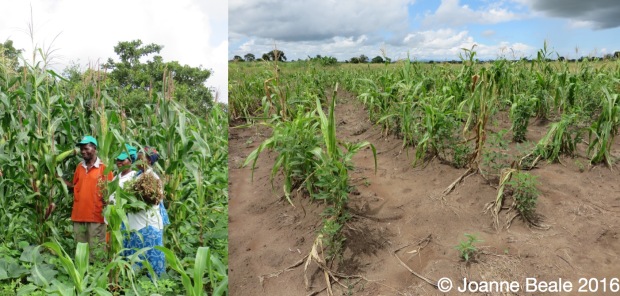“Wells drying up. Crops struggling. Dust coats your hands, the walls of your house, the leaves on the trees. It’s hot. So hot. Everything is parched. No energy to move.”
In 2015 those feelings were quickly replaced by the horror of the constant rain and floods we experienced which washed out peoples farms which had been so desperately needing rain. But not that much.
This year, in complete contrast, those feelings still persist. Now. In March. (The rainy season is traditionally said to start on 15th November). Sure, it rained over Christmas, for maybe 4 days. And it rained again for a day here and there since then. But never enough. In the grand scheme of things, in the scheme of global weather, the rains haven’t come. I asked a friend yesterday: “Are people still hoping that the rain will come or is it time to accept that it is over for this year?” He replied that he didn’t know what to think and that as late as last week people were still hoping. But that hope is rapidly fading. The rains might have failed. It’s still as hot as it was in October, the wells are still drying up, sleep is difficult but that’s not the problem.
People are hungry. The seeds planted when it started raining in December are not producing fruit. The crops are dry, withering or dead. The normal sights of fields of 5’+ maize is replaced by waist-high stunted plants. As a Diocese we did a seed distribution in February so that when the rains came, late as they were, people would be able to try again. (People will have used up all their carefully saved seeds from last year’s crop in December. There’s no way of just getting more seed.) However it now seems that this might have been in vain. In Mecanhelas we have been distributing food as the hunger problem particularly there was so serious. Communities are self selecting the most needy families and they have received small amounts of maize, beans and oil. This has not been straightforward – our colleagues told us last week when we passed through that they have needed police escort to protect them from the violence provoked by desperation. They couldn’t store the food for a second distribution any longer as it was not safe so that was handed out early too. People showed us the grass they are eating. This effect is not short term either. A failure of this years harvest could mean that people go hungry until this time next year.

The need for rain: These photos were taken almost exactly a year apart. The one on the left in 2015 and the one on the right just last week.
This drought has been exacerbated by one of the strongest El Niño effects in many years and scientists now think that these strong El Niño’s are a direct effect of human-induced climate change. Regardless, a change in rainfall patterns is accepted to be the most serious consequence of climate change for sub-Saharan Africa. The Intergovernmental Panel on Climate Change predicts that some countries will have their yield from rain-fed agriculture reduced by more than 50% by 2020. So our experience over the last 2 years is unfortunately likely to become more and more common in this part of the world. For more of the grim reality for Africa see this report.
Changes in weather patterns in themselves are not disastrous. But these effects coupled with certain vulnerabilities are what leads to terrible consequences. In the areas around us people are relying almost exclusively on rain-fed subsistence agriculture. (Though we have a ‘market’ where it is possible to buy food, sacks of maize have risen from 700Mt to 1250Mt, almost an 80% increase, making it unaffordable for many families). A lack of resilient (or any!) infrastructure (roads, sewage, drainage, housing) means more chances of flooding when rains persist, and more chance of sickness.
Some experts say that no amount of adaptation will be able to compensate for these growing levels of unpredictability and that communities will eventually be forced to relocate. However, a little adaptation does help, and some of our field workers are becoming experts on improved agriculture methods, planting experimental farms to show the differences in yield when certain techniques are used. In Mecanhelas in particular the difference is stark. If people have a chance to try again they will be using much more efficient methods to make the most of each seed.
We don’t talk too much about climate change here: there’s certainly very little people can do here to reduce their carbon emissions. Especially given that our electricity is already from hydropower – and we don’t have much of it because of the drought, (are you seeing the horrible cycle?), we only know 2 people who own a car, and there’s very little processing or waste. Sub Saharan Africa accounts for less than 4% of global emissions. But our friends here know all too well the effects.
this is absolutely dreadful Joanne and one feels so helpless. All I can do is pray for rain for your communities and friends. Dad xx
I agree, we feel quite helpless too. Only that it makes more real the effects of our carbon emissions in the UK – so I hope when we move back we will be even more conscious of cutting down on that!